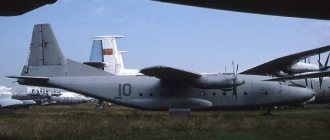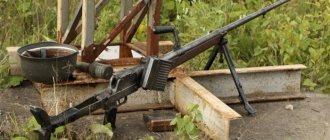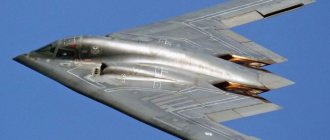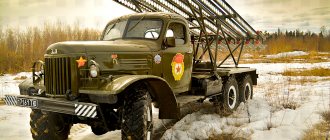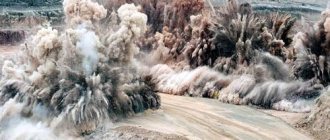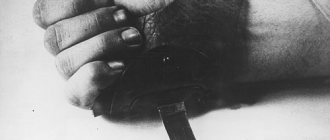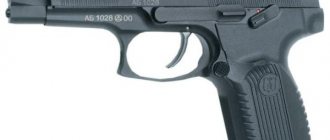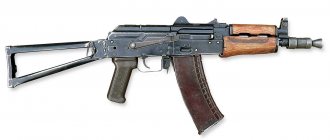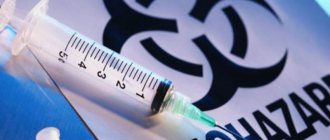| It is proposed to rename this page Pearl Harbor. Explanation of reasons and discussion - on the Wikipedia page: Towards renaming / March 19, 2016 . Perhaps its current name does not correspond to the norms of the modern Russian language and/or the rules for naming Wikipedia articles. Do not remove the flag for renaming until the end of the discussion. Rename to the suggested name, remove this template. |
| Pearl Harbor | |
| English Pearl Harbor, harbour. Puʻuloa | |
| Satellite image; Honolulu International Airport is visible at the bottom right | |
| Characteristics | |
| Bay type | harbor |
| Location | |
| 21°21′43″ n. w. 157°57′13″ W d.HGYAO | |
| Higher water area | Pacific Ocean |
| A country |
|
| Region | Hawaii |
| Pearl Harbor | |
| Audio, photo and video on Wikimedia Commons | |
This term has other meanings, see Pearl Harbor (meanings).
Pearl Harbor
[1][2],
Pearl Harbor
[3] (English: Pearl Harbor -
“Pearl Harbor”
, Harbor Puʻuloa) is a harbor on the island of Oahu (Hawaii). Most of the harbor and surrounding areas are occupied by the central base of the US Navy's Pacific Fleet.
On December 7, 1941, Japan attacked Pearl Harbor, which triggered the United States' entry into World War II.
Preparing for war
The attack on Pearl Harbor was intended to neutralize the US Pacific Fleet, and therefore protect Japan's gains in Malaya and the Dutch East Indies, where it was seeking access to natural resources such as oil and rubber. The possibility of war between Japan and the United States had been considered by both nations since 1921, although tensions began to rise in earnest only in 1931, when Japan invaded Manchuria. Over the next decade, Japan continued to expand its influence in China, leading to all-out war in 1937. Japan spent a lot of effort trying to isolate China and achieve resource independence enough to achieve victory on the mainland; conquests in the south were supposed to help this[3].
Since December 1937, events such as the Japanese attack on the USS Panay and the Nanking Massacre (over 200,000 dead) sharply worsened public opinion of Japan in the West and increased fear of Japanese expansion,[4] prompting the United States to Great Britain and France provide loans to China for military supplies.
In 1940, Japan invaded French Indochina to control supplies to China. The United States stopped supplies of aircraft, metalworking machines and aviation gasoline to Japan, which was perceived in Japan as an unfriendly act. The United States did not stop oil exports to Japan, believing that this would be a last resort, given Japan's dependence on American oil, and would be perceived in Japan as a provocation[5].
In July 1941, following Japanese expansion into French Indochina following the fall of France, the United States stopped exporting oil to Japan (due in part to new American restrictions on domestic oil consumption). This in turn prompted the Japanese to begin seizing the oil-rich Dutch East Indies. The Japanese were faced with a choice: either leave China and lose face, or seize sources of raw materials in the European colonies of Southeast Asia.
In early 1941, President Franklin D. Roosevelt transferred the Pacific Fleet to Hawaii from San Diego and ordered a military build-up in the Philippines in hopes of thwarting Japanese aggression in the Far East. Since Japanese commanders (wrongly) believed that any attack on the British colonies in Southeast Asia would lead to US entry into the war, a devastating pre-emptive strike seemed the only way to avoid US Navy intervention.[6] Japanese strategists also believed that an invasion of the Philippines was necessary. The American plan of action (“War Plan Orange”) envisaged the defense of the Philippines with an elite force of 40,000 men. Douglas MacArthur believed that he needed ten times more troops, but this was not realized[7]. By 1941, American strategists contemplated evacuation from the Philippines at the start of the war, and orders to this effect were given in late 1941 to Admiral Thomas Hart, commander of the Asiatic Fleet.[8]
According to John Koster, a certain role may have been played by the Soviet intelligence operation called Operation Snow, carried out in April 1941, as a result of which, through a very influential employee of the US Treasury Department, Harry Dexter White, information was brought to President Roosevelt about Japan's preparations for war against the United States. In this regard, the idea arose to put pressure on Japan. The United States demanded that Japan immediately stop its aggression in China and withdraw troops from all Chinese territories except Manchukuo, withdraw from the Tripartite Pact with Germany and Italy, and neutralize Manchukuo[9].
Preliminary planning for an attack on Pearl Harbor to protect advances into the "Southern Resource Region" (the Japanese term for the Dutch East Indies and Southeast Asia in general) began early in 1941 under the auspices of Admiral Isoroku Yamamoto, then commander of the Japanese Combined Fleet. [10]. He received approval for formal planning and preparations for the attack from the Imperial Japanese Navy General Staff only after much dispute with the naval command, including a threat to resign. Full-scale planning began in the early spring of 1941, primarily by Captain Minoru Genda. Japanese strategists carefully studied the British air attack on the Italian fleet at Taranto in 1940. This was very useful for them when planning the attack on the US naval forces at Pearl Harbor[11][12].
It would not be superfluous to mention that in 1932 and 1937 the American fleet conducted major exercises, during which they practiced striking aircraft from aircraft carriers at Pearl Harbor. In both cases, the attacking aircraft were successful. However, the American command did not take the results of these exercises seriously enough, believing that in reality the enemy would not be able to carry out an effective attack on the base. The Japanese, on the contrary, rated the idea as very promising.
Over the next few months, pilots were trained, equipment was adapted, and intelligence was collected. Despite these preparations, the attack plan was not approved by Emperor Hirohito until November 5, after the third of four imperial conferences called for consideration of the issue.[13] Final permission was not given by the Emperor until December 1, after most Japanese leaders informed him that Nota Halla would "destroy the fruits of the Chinese incident, threaten Manchukuo, undermine Japanese control of Korea."[14]
By the end of 1941, many observers believed that hostilities between the United States and Japan were inevitable. A Gallup poll shortly before the attack on Pearl Harbor found that 52% of Americans expected war with Japan, 27% did not expect war, and 21% had no opinion.[15] While US Pacific bases and installations were put on alert several times, the US military doubted that Pearl Harbor would be the first target. They expected the Philippines to be attacked first. This assumption was due to the threat that air bases throughout the country and the naval base in Manila posed to shipping lanes, as well as supplies to Japan from the south.[16] In addition, they mistakenly believed that Japan was unable to carry out more than one major naval operation at a time.[6]
Pearl Harbor
On December 7, 1941, Japanese planes attacked an American military base in Pearl Harbor and the United States found itself an active participant in World War II, and ultimately its beneficiary.
The report on losses after the attack on Pearl Harbor by Secretary Knox stated what was apparently intended from the very beginning: “The overall balance of power in the Pacific in terms of aircraft carriers, cruisers, destroyers and submarines was not affected. They are all at sea and are looking for contact with the enemy,” that is, the Japanese attack did not cause any tangible damage. The fate of the American fleet based in the Gulf had already been decided, but in November 1941, Roosevelt asked about the upcoming events: “how should we bring them to the first strike position so that the damage would not be too destructive for us?”, which he wrote about in his diary. Recorded by Minister Stimpson. Already in our time, the Japanese political scientist and grandson of Shigenori Togo, the Minister of Foreign Affairs in the early 40s, Kazuhiko Togo, with bewilderment Fr. Indeed, by order of the US Navy command, Kimmel sent two aircraft carriers, six cruisers and 14 destroyers to the islands of Midway and Wake, that is, the most expensive equipment was removed from the attack, which will finally become clear from the commission’s report. To understand how this happened, it is necessary to reconstruct the course of previous events. The first attempt in '39 to change the US Neutrality Act, which would allow states to enter the war, encountered opposition from Senator Vandenberg and the so-called "National Committee", which included Henry Hoover, Henry Ford and Governor LaFollette. “Post-war documents and declassified documents of Congress, as well as the death of Roosevelt himself,” according to W. Engdahl: “show beyond any doubt that the President and his Secretary of Defense Henry Stimson deliberately incited Japan to war.” Robert Stinnett's book "Day of Lies: The Truth About the Federal Reserve Fund and Pearl Harbor" says that the Roosevelt administration provoked the Japanese attack because its further actions could not be called anything other than a provocation.
On June 23, 1941, a note from presidential aide Harold Ickes landed on Roosevelt's desk, indicating that "an embargo on oil exports to Japan could be an effective way to start a conflict." The very next month, Deputy Secretary of State Dean Acheson banned the Japanese from importing oil and petroleum products from the United States. The Japanese fleet, according to Admiral Nagano, “burned 400 tons of oil per hour,” which the Japanese could only obtain by seizing the oil resources of Indonesia (Dutch East Indies), the Philippines and Malaysia. On November 20, 1941, Japanese Ambassador Nomura made a proposal for a peaceful resolution of the conflict, which included the clause: “The United States Government will supply Japan with the necessary amount of oil.” In addition to the fact that the United States interrupted shipping communications with Japan and closed the Panama Canal to Japanese ships, on July 26, Roosevelt signed a decree on the seizure of Japanese banking assets worth a significant amount of $130 million at that time and the transfer of all financial and trade transactions with Japan under government control. The United States ignored all subsequent requests from politicians from the Land of the Rising Sun for a meeting of the heads of both countries to resolve relations.
On November 26, 1941, the Japanese ambassador to the United States, Admiral Nomura, was given a written demand to withdraw Japanese armed forces from China, Indonesia and North Korea, to terminate the tripartite pact with Germany and Italy, such an ultimatum response to Nomura’s proposals was clearly interpreted by Japan as the reluctance of the United States to resolve differences peacefully .
On May 7, 1940, the Pacific Fleet received an official order to remain in Pearl Harbor indefinitely; its leader, Admiral J. Richardson, in October tried to convince Roosevelt to withdraw the fleet from the Hawaiian Islands, since there it did not have a restraining influence on Japan. “...I must tell you that the senior officers of the fleet do not trust the civilian leadership of our country,” the admiral summed up the conversation, to which Roosevelt, in turn, remarked: “Joe, you don’t understand anything.” In January 1941, J. Richardson was fired, and his post was taken by Husband Kimmel, from whom not only were consistently hidden documents that could suggest that the target of the attack would be Pearl Harbor, but also, on the contrary, demonstrated those that had been created false impression of an impending attack on the Philippines.
William Endgall's book talks about documents that "prove that Roosevelt was fully aware of the plans for the bombing of Pearl Harbor several days before it began, down to the details of the movements of the Japanese fleet in the Pacific and the exact time of the operation." Churchill also admitted: Roosevelt “was fully aware of the immediate goals of the enemy operation. In fact, Roosevelt instructed the director of the International Red Cross to prepare for large casualties at Pearl Harbor because he had no intention of preventing or defending against a potential attack."
At a minimum, it is known for sure that on November 26, the day after the Secretary of War wrote about the imminent attack on Pearl Harbor, the British Prime Minister informed Roosevelt, indicating the exact date. Kimmel. Previously, when he tried to prepare for a clash with Japanese troops, the White House sent a notice that he was “complicating the situation,” and in late November he was told to completely stop conducting reconnaissance against a possible airstrike. A week before the tragic events, it was decided to leave the sector in the direction of 12 hours without patrolling, anti-aircraft artillery was not ready, in accordance with anti-sabotage warning No. 1 technician, and the ships were herded into dense groups, which made them easy prey for air attack. The US Army commission that followed the event summed up the situation as follows: “everything was done to maximally favor an air attack, and the Japanese did not fail to take advantage of this.”
Colonel O. Sadtler, who, by virtue of his position, was familiar with the contents of Japanese correspondence and found coded words in it warning of an impending attack, also tried to prevent an attack on the American fleet. He wrote a warning to all garrisons, including Pearl Harbor, on behalf of the Chief of Staff, General J. Marshall, but he was practically ridiculed, despite the fact that the command knew from secret correspondence about the offensive operation developed in Tokyo under the code name "Magic", and quite may have known that on January 7, 1941, Secretary of the Navy Koshiro Oikawa was studying a nine-page justification for the attack on Pearl Harbor. On September 24, 1941, it became known from incoming encryption that Japanese naval intelligence was requesting squares of the exact location of US ships in Pearl Harbor.
Regarding the deciphered Japanese codes, it is noteworthy that the head of the then official intelligence structure of the Special Operations Executive, William Donovan, who located his office in room 3603 of the Rockefeller Center, was excluded from among the recipients of the decrypted materials by the Army Chief of Staff, General George Marshall. It is also noteworthy that individual unit headquarters received a machine for deciphering the code, but the Pearl Harbor group did not receive a machine for deciphering the code, that is: in Rockefeller Center and on the base itself, they were not supposed to know about the impending provocation. It is possible that Roosevelt “did not look surprised” on the day of the news of the attack on Pearl Harbor, as William Donovan later recalled, because he himself was doing his best to bring it closer, because he was worried, according to the head of the Special Operations Executive, only that the public did not supported the declaration of war.
US intelligence services have been reading the encrypted correspondence of the Japanese fleet since the second half of the 20s, secretly re-photographing code books with the so-called “red code”. In 1924, the future head of the radio interception and decoding department at headquarters, Captain Lawrence F. Safford, joined the team of codebreakers, whose position during the hearings on the events related to Pearl Harbor would cause many to doubt the official version. Since 1932, Safford, using IBM equipment, has been developing those same decryption machines; in 1937, special radio stations were deployed for radio interception along a giant arc from the Philippines to Alaska.
The efforts of more than 700 employees under the leadership of L. Safford and W. Friedman in August 1940 culminated in deciphering the complex “pink” or “purple code” that encrypted Japanese government diplomatic correspondence. In addition to the high command, the US leadership was aware of the success of the codebreakers: President F. Roosevelt, Secretary of State C. Hull, Secretary of War G. Stimson and Secretary of the US Navy F. Knox, who were not familiar with only four of the 227 documents that made up the secret correspondence between Tokyo and the Japanese embassy in the USA. Accordingly, it is likely that they were aware of the contents of the meeting of the Imperial Government held on September 6, 1941 in the presence of the Emperor, which stated that if “there is no significant hope of reaching an agreement with our demands through the above-mentioned diplomatic negotiations, we will immediately decide on imposing readiness for war against the United States."
Between November 28 and December 6, seven codes were intercepted confirming that Japan intended to attack Pearl Harbor. The inevitability of war with Japan finally became known the day before the attack on Pearl Harbor; six hours before the attack, its exact time became known - 7.30, which the US Army command decided to inform Hawaii not by a telephone call, but by a regular telegram that reached the addressee when the fleet was already sunk. And just before the attack, two soldiers on duty on the radar noticed Japanese planes, but no one answered the call to headquarters, and half an hour later, Kimmel’s wife, standing in a nightgown in the courtyard of her villa, was already reporting to her husband: “It looks like they covered the battleship Oklahoma "!"
In total, during the attack, 2403 (according to N. Yakovlev - 2897) base employees were killed, 188 aircraft were destroyed, the old target ship "Utah", the minelayer "Oglala", the destroyers "Kassin", "Daune" and "Shaw" and battleship Arizona, the burning image of which became a symbol of the defeat of Pearl Harbor. The death of the Arizona brought the largest number of victims - 47 officers and 1056 lower ranks, but added a number of questions. According to Nimitz's research, the Arizona was destroyed by a Val-234 dive bomber, but it would not have been able to lift the 800-kg bomb that allegedly destroyed the battleship; the Arizona also did not receive torpedo hits. Moreover, an examination of the ship by divers showed that the battleship, which was considered an impregnable fortress, sank as a result of a series of explosions that occurred inside the ship. Secretary of the Navy Frank Knox then concluded that the bomb hit the battleship's smokestack.
Roosevelt himself appointed the composition of the first commission of Chief Justice O. Roberts, which was supposed to find out the circumstances of the tragedy. Her report was published many times, but never before 1946 were the 1,887 pages of interview transcripts and more than 3,000 pages of documents presented to the general public, since their contents obviously contradicted the conclusions, however, the President thanked O. Roberts “for his thorough and comprehensive investigation.” , which placed all the blame on the chief of the garrison, Walter Short, and Husband Kimmel, who was dismissed on March 1 with a promise to later be tried by a military tribunal. After the fateful tragedy, both worked in military production. In 1943, Kimmel requested materials from the Navy Department, but was refused under the pretext of security.
In 1944, presidential candidate Thomas Dewey intended to publicize the Japanese code story, which clearly implied that Roosevelt knew about the impending operation, but the Chairman of the Joint Chiefs of Staff, General J. Marshall convinced him not to show his cards to the Japanese during the war. The following year, the Senate considered E. Thomas's bill, which provided for 10 years in prison for disclosing encrypted materials, but the Republicans rejected it, and more than 700 decrypted Japanese documents were presented to the new commission. Although the Republican members of the commission showed particular zeal in the investigation, they were forbidden to independently study the archives of government departments, and Secretary Grace Tully issued documents from the personal archive of the then deceased president at her own discretion. There were other oddities
“The testimony records are full of contradictions. What was said in the fall of 1945 invariably contradicted the testimony given before previous investigative commissions. In 1945, the documents were either hidden or disappeared, and the memory of the participants in the events was “refreshed”, or they completely forgot what happened. Therefore, in a number of cases persistent questions were answered with a stereotypical answer: “I don’t remember.” Even the senators who were eager to make political capital from the investigation grew tired and stopped delving into the case.” N. Yakovlev “Pearl Harbor, December 7, 1941 - Fact and Fiction” The Japanese telegram of December 4, 1941, warning about the outbreak of war was deciphered and sent to US leaders, but already in 1944 the War Ministry commission stated: “The original telegram disappeared from the archives of the naval forces... There were copies in other places, but now they have all disappeared... Over the past year, the radio station logs in which the receipt of the telegram was recorded were destroyed. An army witness testified that the army command never received this telegram.” One by one, the witnesses began to get confused in their memories. A. Krammer, who was in charge of the translation and distribution of deciphered materials, who was known as an absolute pedant, inserted his favorite word “exactly!” everywhere. After lunch with Admiral Stark, he suddenly began to give inconsistent testimony. This was achieved not only by having lunch with the higher command, but also by placing him in the psychiatric ward of the Bethesda naval hospital, from where, according to relatively modern research, he was released in exchange for changing his testimony and under the threat of lifelong imprisonment. The head of naval intelligence, Vice Admiral Theodore Wilkinson, presented the commission with 11 radio intercepts, which, as Marshall and others showed, did not exist, but in February 1946, during the work of the last commission, the car he was driving rolled off a ferry, which led to the death of the witness .
Also a “tough nut to crack” was the creator of decryption machines, Lawrence Safford, who earned the nickname “mad genius” from his subordinates for good reason. In February 1944, he appeared before Kimmel, claiming to have evidence that the admiral was “the victim of the most foul conspiracy in the history of the Navy,” which apparently inspired the admiral to tell Navy Chief E. King on November 15, 1945: “Immediately after Pearl Harbor, I believed that... I had to take the blame for Pearl Harbor... Now I refuse to accept any responsibility for the disaster at Pearl Harbor." By this time, at least the ninth investigation had already taken place, and it still did not clarify the reasons that brought the United States into the world war. The latter was headed in 1946 by a lawyer with the revealing surname Morgan.
Safford stubbornly insisted that on December 4, having received a telephone message with a code word that meant war, he immediately reported this to Rear Admiral Knox. Safford was the only one to address the Navy's investigative committee, pointing out the pressure being applied. Chief Counsel Richardson pestered Safford for hours, resorting to legal maneuvers and pushing his testimony to the point of absurdity: “So, what you're saying is that there was a vast conspiracy from the White House, through the War Department, the Navy Department, through the Kramer Division, to destroy these copies?” To which Safford only retorted that the chief adviser is not the first who is trying to force him to change his testimony. Corresponding with researchers, he intrigued the public for another three decades, and most of all his wife, who out of harm’s way let journalists down the stairs and burned all the papers found in the house that mentioned Pearl Harbor, as a result of which Safford began to encrypt his notes from her.
Even modern researchers note that it is extremely difficult to investigate the nature of the incident that dragged the United States into the war, since secret dispatches were removed from the materials of the US Congress hearings, and later became available only in special archives. One of the researchers, Robert Stinnett, believes that President Roosevelt, Secretary of State Hull, Secretary of War Stimson and nine other people from the military leadership, whom Stimson himself lists in his diary, were behind the deliberate provocation of the attack on Pearl Harbor. Using the Freedom of Information Act, Stinnett spent a long time collecting documents that had survived censorship and came to the conclusion that the main organizer of the provocation was, after all, Roosevelt, who received a memo from naval intelligence officer A. McCollum in October 1940 (A. McCollum), containing instructions of eight actions, including an embargo, which were guaranteed to lead to war. However, for known reasons, the official version remains different.
Pearl Harbor before the attack
The location of ships in Pearl Harbor on the eve of the Japanese attack
Back in mid-1941, Roosevelt wrote to Churchill: “It is possible that I will never declare war, but simply start it. If I asked Congress to declare war, the debate on this issue could drag on there for three months.”
In early October, two months before the "surprise" attack, Soviet intelligence officer Richard Sorge reported to Moscow that Pearl Harbor would be attacked within 60 days; this data, according to American sources, was brought to the attention of Washington by the Kremlin.
From recently[ when?
] documents declassified in the United States, it became known about the meeting that the German envoy to China, Hans Thomsen, arranged for New York businessman Malcolm Lovell in mid-November 1941. A German diplomat, knowing about the businessman's connections with the White House, told him about the upcoming Japanese attack. In turn, Lovell immediately reported this to one of the chiefs of American intelligence, William Donovan, who on the same day conveyed the information received personally to the president. Less than three weeks remained before the attack on Pearl Harbor.
On the evening of December 6, a Japanese note was intercepted and decrypted in Washington - a response to the American ultimatum of November 26. Although the lengthy document did not directly speak of a declaration of war, its entire meaning and the indication of the exact hour of delivery - 1 o'clock in the afternoon on December 7 - spoke for themselves, but no warning was sent to Hawaii, where the entire Pacific Fleet was based. On December 6 at 21:30 (Washington time), the Japanese note was delivered to Roosevelt. After reading it, the president remarked: “This is war.”
The main events of December 7, 1941 unfolded around Fr. Ford Island, a small island in the center of the East Loch of Pearl Harbor Bay. There was a naval airfield on the island, and there were ship moorings around it.
Off the southeastern shore of the island. Ford is located on the so-called “Battleship Row” - 6 pairs of massive concrete piles designed for mooring heavy ships. The battleship is moored simultaneously to two piles. A second ship can moor alongside it.
At the time of the Japanese attack, 7 of the 9 battleships of the US Pacific Fleet were in the battleship row.
50 minutes before the attack, the planes of the Empire of Japan were detected by the American SCR-270 radar located in the north of the island, but the Americans considered these planes to be theirs, so the alarm was not raised[17].
Why was the attack successful?
The Japanese navy was able to successfully carry out the attack on Pearl Harbor due to communications breakdowns between various branches of the US government and the military. The island was poorly protected from air attack because American military commanders underestimated Japan's ability to conduct an operation of this scale. Additionally, it is unclear how much information was gathered about a possible Japanese attack on American installations and, if so, whether such information was taken seriously. Shortly after the attack, two of the base's military commanders, Admiral E. Kimmel and Lt. Gen. Walter Short, were demoted.
Japanese aviation
In total, three types of aircraft were based on the Japanese aircraft carriers that participated in the attack on Pearl Harbor, widely known by the code names given to them in the American Navy: Zero fighters, Kate torpedo bombers and Val dive bombers. Brief characteristics of these aircraft are given in the table.
| Type | American title | Speed, km/h | Flight range, km | Armament | Crew | Purpose |
| Aichi D3A1 , type 99 | Val | 450 | 1400 | 250 kg bomb under the fuselage, two 60 kg bombs under the wings, three 7.7 mm machine guns | 2 | Dive bomber |
| Mitsubishi A6M2 , model 11 | Zero | 545 | 1870 | two 20-mm cannons and 7.7 mm machine guns, two 60-kg bombs under the wings | 1 | Fighter |
| Nakajima B5N2 , type 97 model 12 | Kate | 360 | 1100 | 457 mm torpedo or more than 500 kg bombs or 800 kg bomb, 7.7 mm machine gun | 2-3 | Torpedo bomber, high-altitude bomber |
Aircraft of the first wave
O. Oahu, Hawaiian Islands. Diagram of the first wave of Japanese airstrikes on the Pearl Harbor base Events in Pearl Harbor Bay during the first wave of Japanese airstrikes
| Group number | Aircraft carrier | Qty | Planned goals |
| Kate high-altitude bombers Armament: 800 kg armor-piercing bomb | |||
| 1c | "Akagi" | 15 | "Maryland", "Tennessee", "Zap. Virginia" |
| 2v | "Kaga" | 14 | "Arizona", "Tennessee", "Zap. Virginia" |
| 3v | "Soryu" | 10 | "Nevada", "Tennessee", "Zap. Virginia" |
| 4v | "Hiryu" | 10 | "Arizona", "California" |
| TOTAL: | 49 | ||
| Torpedo bomber "Kate" Armament: Mk91 aircraft torpedo | |||
| 1t | "Akagi" | 12 | "Zap. Virginia", "Oklahoma", "California" |
| 2t | "Kaga" | 12 | "Zap. Virginia", "Oklahoma", "Nevada" |
| 3t | "Soryu" | 8 | "Utah", "Helena", "California", "Rayleigh" |
| 4t | "Hiryu" | 8 | "Zap. Virginia", "Oklahoma", "Helena" |
| TOTAL: | 40 | ||
| Val dive bombers Armament: 250 kg aerial bomb | |||
| 1p | "Shoukaku" | 26 | Hickam |
| 2p | "Zuikaku" | 25 | Weller |
| TOTAL: | 51 | ||
| Zero fighters Armament: 20 mm cannons and 7 mm machine guns | |||
| 1i | "Akagi" | 9 | Hickam, Eva, Fr. Ford |
| 2i | "Kaga" | 9 | Hickam, Fr. Ford |
| 3i | "Soryu" | 8 | Weller, Eva, planes at Cape Barbers |
| 4i | "Hiryu" | 6 | Weller, Eva, planes at Cape Barbers |
| 5i | "Shoukaku" | 6 | Kaneohe, Bellows |
| 6i | "Zuikaku" | 5 | Kaneohe |
| TOTAL: | 43 | ||
| TOTAL in the first wave: | 183 | ||
Aircraft of the second wave
O. Oahu, Hawaiian Islands. Diagram of the second wave of Japanese airstrikes on the Pearl Harbor base Events in Pearl Harbor Bay during the second wave of Japanese airstrikes
| Group number | Aircraft carrier | Qty | Planned goals |
| Kate high-altitude bombers Armament: 250 kg aerial bomb and 6 60 kg aerial bombs | |||
| 1c | "Shoukaku" | 9 | Seaplane base o. Ford |
| 2v | "Shoukaku" | 18 | Kaneohe |
| 3v | "Zuikaku" | 27 | Hickam |
| TOTAL: | 54 | ||
| Val dive bombers Armament: 250 kg aerial bomb | |||
| 1p | "Akagi" | 18 | Tanker "Neosho", o. Ford, Maryland |
| 2p | "Zuikaku" | 17 | Navy shipyard |
| 3p | "Soryu" | 17 | Navy shipyard, docks, battleships |
| 4p | "Kaga" | 26 | Navy shipyard, docks, battleships |
| TOTAL: | 78 | ||
| Zero fighters Armament: 20 mm cannon | |||
| 1i | "Akagi" | 9 | Hickam Aerodrome |
| 2i | "Kaga" | 9 | Hickam Airfields Ford, Weller |
| 3i | "Soryu" | 9 | Kaneohe Airfield |
| 4i | "Hiryu" | 8 | Airfields Kaneohe, Bollows |
| TOTAL: | 35 | ||
| TOTAL in the second wave: | 167 | ||
Hawaii overprint
on US dollars after the attack on Pearl Harbor in case of occupation of the islands by Japan. 1942
Story
To attack Pearl Harbor, the Japanese command allocated an aircraft carrier force under the command of Vice Admiral Chuichi Nagumo, consisting of 23 ships and 8 tankers.
The formation consisted of a Strike Group consisting of six aircraft carriers: Akagi, Hiryu, Kaga, Shokaku, Soryu and Zuikaku (1st, 2nd and 5th aircraft carrier divisions), Group cover (2nd detachment of the 3rd battleship division), two heavy cruisers (8th cruiser division), one light cruiser and nine destroyers (1st destroyer squadron), an advance detachment consisting of three submarines and a supply detachment of eight tankers. (Futida M., Okumiya M. The Battle of Midway Atoll. Translated from English. M., 1958. P. 52.) The aviation group of the formation consisted of a total of 353 aircraft. The operation, which was carefully planned and prepared, was led by the commander of the combined Japanese fleet, Admiral Isoroku Yamamoto. Particular importance was attached to achieving surprise in the attack. On November 22, 1941, the task force gathered in the strictest secrecy in Hitokappu Bay (Kuril Islands) and from here, observing radio silence, headed for Pearl Harbor on November 26. The transition took place along the longest (6300 km) route, characterized by frequent stormy weather, but least visited by ships. For camouflage purposes, a false radio exchange was made, which simulated the presence of all large Japanese ships in the Inland Sea of Japan. (Soviet military encyclopedia. T.6. P. 295.)
Briefing on the deck of the aircraft carrier Kaga before the attack on Pearl Harbor However, for the American government, the Japanese attack on Pearl Harbor was not so unexpected. The Americans deciphered the Japanese codes and read all Japanese messages for several months. The warning about the inevitability of war was sent on time - November 27, 1941. The Americans received a clear warning about Pearl Harbor at the last moment, on the morning of December 7, but the instruction about the need to increase vigilance, sent via commercial lines, reached Pearl Harbor only 22 minutes before the Japanese attack began, and was transmitted to the messengers only at 10:45 minutes when it was all over. (See: History of the War in the Pacific. T.Z.M., 1958. P. 264; The Second World War: Two Views. P. 465.)
In the predawn darkness of December 7, Vice Admiral Nagumo's aircraft carriers reached the aircraft lifting point and were 200 miles from Pearl Harbor. On the night of December 7, 2 Japanese destroyers fired on the island. Midway, and 5 Japanese midget submarines launched at Pearl Harbor began operating. Two of them were destroyed by American patrol forces.
At 6.00 on December 7, 183 aircraft of the first wave took off from aircraft carriers and headed for the target. There were 49 attack aircraft - type 97 bombers, each of which carried an 800-kilogram armor-piercing bomb, 40 attack torpedo bombers with a torpedo suspended under the fuselage, 51 dive bombers of the 99 type, each carrying a 250-kilogram bomb. The covering force consisted of three groups of fighters, numbering a total of 43 aircraft. (Futida M., Okumiya M., op. cit. p. 54.)
The first aircraft is ready to take off from the USS Shokaku at Pearl Harbor. The skies over Pearl Harbor were clear. At 7:55 am, Japanese planes attacked all large ships and aircraft at the airfield. There was not a single American fighter in the air, and not a single gun flash on the ground. As a result of the Japanese attack, which lasted about an hour, 3 battleships were sunk and a large number of aircraft were destroyed. Having finished bombing, the bombers headed for their aircraft carriers. The Japanese lost 9 aircraft. Destroyed Naval Air Station in Pearl Harbor The second wave of aircraft (167 aircraft) took off from the aircraft carriers at 7:15 am. In the second wave there were 54 attack bombers of the 97 type, 78 dive bombers of the 99 type and 35 fighter jets, which covered the actions of the bombers. The second strike by Japanese planes met stronger American resistance. By 8.00 the planes returned to the aircraft carriers. Of all the aircraft that took part in the air raid, the Japanese lost 29 (9 fighters, 15 dive bombers and 5 torpedo bombers). Manpower losses amounted to a total of 55 officers and men. In addition, the Americans sank one submarine and 5 midget submarines, whose actions turned out to be ineffective. The abandonment of the battleship Nevada inside the harbor during the attack on Pearl Harbor. On this day, she became the only American battleship that managed to get underway and tried to leave the bay. However, due to the threat of sinking by the Japanese in the fairway, the Nevada was ordered to beach. In total, during the attack on Pearl Harbor, the battleship Nevada was hit by 1 aerial torpedo and 2-3 aerial bombs, after which it ran aground.
Japanese fleet attack
On November 26, 1941, a strike force of the Imperial Japanese Navy under the command of Vice Admiral Chuichi Nagumo, on the orders of Fleet Commander Isoroku Yamamoto, left the base in Hitokappu Bay (now Kasatka Bay) on Iturup Island (Kuril Islands) and headed for Pearl Harbor. The Japanese force included six aircraft carriers: Akagi, Kaga, Hiryu, Soryu, Shokaku and Zuikaku, which carried 414 aircraft, including fighters, torpedo bombers and dive bombers. The aircraft carriers were escorted by 2 battleships, 2 heavy and 1 light cruiser and 9 destroyers (2 more destroyers had separated earlier to conduct a separate operation to shell Midway Atoll). The operation against Oahu also involved 6 submarines, delivering midget submarines to the attack site and later patrolling around the Hawaiian Islands.
The purpose of the attack on Pearl Harbor was to neutralize the US Pacific Fleet in order to ensure freedom of action for the Japanese army and navy in Southeast Asia. This goal could not be achieved, since the modern types of ships of the Pacific Fleet - aircraft carriers and submarines - were not damaged. Of the 8 American battleships, mostly obsolete, from the First World War, that were parked in Pearl Harbor, the Arizona (the ammunition exploded) and the Oklahoma (overturned, raised and sent for disposal) were irretrievably lost. Pennsylvania and Maryland received minor damage and returned to service at the end of the month. Tennessee and Nevada suffered more serious damage and were repaired by February and October 1942, respectively. "California" and "West Virginia" were restored only in 1944.
On the morning of December 7, aircraft from Japanese aircraft carriers attacked airfields on the island of Oahu and ships anchored in Pearl Harbor. The most convenient moment for the attack was chosen - it was Sunday, some of the teams and personnel of the coastal defense batteries were on leave. Of the 32 coastal defense batteries, only 8 opened fire on the attackers, of which 4 were quickly suppressed.
Background
After the First World War, the Pacific Ocean became an arena of contradictions between two strong maritime states - the USA and Japan. The United States, rapidly rising to the position of the leading world power, sought to establish control over this strategically important region. Japan, which was experiencing serious difficulties in providing strategic materials and considered itself deprived of colonies in Southeast Asia, was striving for the same goal. The contradictions inevitably had to result in a military conflict, but this was prevented by the isolationist and anti-war sentiments that dominated American public opinion. These moods could only be destroyed by a strong psychological shock, which did not take long to arrive. The introduction of economic sanctions against Japan by the United States, which included an embargo on the supply of petroleum products, made war inevitable. Japan was faced with a choice - to suffocate under the economic blockade or die with honor, trying to obtain the resources it needed in battle. The top Japanese generals understood that for an unconditional victory over the United States it was necessary to defeat the American Pacific Fleet, land troops on the west coast of the United States and fight to Washington, which, given the ratio of the economic and military potentials of the two countries, was completely unrealistic. Forced to enter the war under pressure from the political elite, they relied on the only chance they had - with one powerful blow, inflicting unacceptable damage on the United States and forcing them to sign peace on terms favorable to Japan.
Losses
As a result of the attack, 4 battleships, 2 destroyers, and 1 minelayer were sunk. Another 4 battleships, 3 light cruisers and 1 destroyer were damaged. American aviation losses amounted to 188 aircraft destroyed, another 159 were seriously damaged. 2,403 Americans were killed (1,102 on board the USS Arizona) and 1,178 were wounded.[18] The Japanese lost 29 aircraft, and another 74 were damaged[18]. Five midget submarines were lost due to various reasons[19]. Losses in people amounted to 64 people killed (55 pilots, 9 submariners)[20]. Another one, Lieutenant Kazuo Sakamaki, was captured. He washed ashore after his midget submarine hit a reef. The nine Japanese submariners who died were declared national heroes.
Notes
- The battleships West Virginia (BB-48) and California (BB-44) were sunk at Pearl Harbor and subsequently raised and returned to service.
- Parillo, 2006, p. 288
- Barnhart, Michael A. (1987), Japan prepares for total war: the search for economic security, 1919–1941
, Cornell University Press, ISBN 978-0-8014-1915-7, - Werner Gruhl (2007). Imperial Japan's World War Two, 1931—1945
. Transaction Publishers. p.39. ISBN 978-0-7658-0352-8 - Document text, Peace and War, United States Foreign Policy 1931–1941
, Washington DC: United States Government Printing Office, 1943, . Retrieved December 8, 2007. - ↑ 1 2
Peattie, Mark R. & Evans, David C. (1997),
Kaigun: Strategy, Tactics, and Technology in the Imperial Japanese Navy
, Naval Institute Press, ISBN 0-87021-192-7, - William Chalek (2002), 8. War Plan Orange, Guest of the Emperor
, iUniverse, p. 45–52, ISBN 978-0-595-23996-2, - Edward S. Miller (2007), War Plan Orange: The US Strategy to Defeat Japan, 1897–1945
, Naval Institute Press, p. , ISBN 978-1-59114-500-4, - John Koster. Pearl Harbor 2.0
- Gailey, Harry A. (1997), War in the Pacific: From Pearl Harbor to Tokyo Bay
, Presidio, ISBN 0-89141-616-1 - Borch, Frederic L. & Martinez, Daniel (2005), Kimmel, Short, and Pearl Harbor: the final report revealed
, Naval Institute Press, ISBN 978-1-59114-090-0, - Hellions of the Deep: The Development of American Torpedoes in World War II.
By Robert Gannon, Published by Penn State Press, 1996, page 49.ISBN 0-271-01508-X - Wetzler, Peter (1998), Hirohito and war: imperial tradition and military decision making in prewar Japan
, University of Hawaii Press, ISBN 978-0-8248-1925-5, - Bix, Herbert P. (2000), Hirohito and the Making of Modern Japan
, Diane Pub Co, ISBN 978-0-7567-5780-9, - The Canadian Institute of Public Opinion
.
Gallup Poll Found 52p.c. of Americans Expected War, Ottawa Citizen
(December 8, 1941), p. 1. Retrieved November 28, 2011. - Noted by Arthur MacArthur in the 1890s. Manchester, William. American Caesar
- Yakovlev N.N.
Pearl Harbor, December 7, 1941. Fact and fiction. - M.: Politizdat, 1988. - P. 72-73. — 286 p. — 100,000 copies. - ↑ 12
PEARL HARBOR ATTACK - 7 December 1941 - Zimm A. Attack on Pearl Harbor: Strategy, Combat, Myths, Deceptions, Casemate Publishers, 2013 ISBN 978-1-61200-197-5
- Martin Gilbert. The Second World War (1989). P. 272.
Literature
- Bubnov A.D., rear admiral. Japan's preparation strategy for the war in the Pacific (in Serbo-Croatian?) // [Bizerta]. Marine collection. 1921. No. 7.
- Golovin N.N., Lieutenant General, Bubnov A.D., Rear Admiral. Strategy of the American-Japanese War./Foreword by K. Radek. - Moscow: Military Bulletin, 1925.
- Campaigns of the War in the Pacific. Materials of the commission to study the strategic bombing of United States aviation / Translation from English, ed. Admiral of the Fleet of the Soviet Union I.S. Isakov. - M.: Voenizdat, 1956. - 558 p.
- Pearl Harbor. Ed. N. Anichkin. - M.: Eksmo, 2010. - ISBN 978-5-699-39244-5
- Lord Walter.
Day of shame - Yakovlev N.N.
Pearl Harbor, December 7, 1941. Fact and fiction. - Moscow: Politizdat, 1988. - [www.wunderwaffe.narod.ru/Magazine/AirWar/44/index.htm Pearl Harbor: Japan Strikes]
- Turk G.
Tora-tora-tora! — 1969 - Parillo, Mark (2006), The United States in the Pacific, in Higham, Robin & Harris, Stephen, Why Air Forces Fail: the Anatomy of Defeat
, The University Press of Kentucky, ISBN 978-0-8131-2374-5, - Buranok S. O.
Pearl Harbor in the assessments of US military and political figures 1941-1945. - Samara: As Gard, 2009. - 238 p. — ISBN 978-5-91715-033-8 - Buranok S. O.
The Pearl Harbor tragedy and the American press // New and recent history. 2010. No. 5. - M.: Nauka, 2010. - P. 210-220. - Buranok S. O.
“Report on the actions of December 7, 1941” by Admiral H. Kimmel: research, publication of the text and translation. - Samara: As Gard, 2011. - 156 p. — ISBN 978-5-4259-0027-2 - Barnhart, Michael A. (1987), Japan prepares for total war: the search for economic security, 1919–1941
, Cornell University Press, ISBN 978-0-8014-1915-7, - Bix, Herbert P. (2000), Hirohito and the Making of Modern Japan
, Diane Pub Co, ISBN 978-0-7567-5780-9 - Borch, Frederic L. & Martinez, Daniel (2005), Kimmel, Short, and Pearl Harbor: the final report revealed
, Naval Institute Press, ISBN 978-1-59114-090-0, - Conn, Stetson; Fairchild, Byron & Engelman, Rose C. (2000), 7 – The Attack on Pearl Harbor, Guarding the United States and Its Outposts
, Washington DC: Center of Military History United States Army, - Gailey, Harry A. (1997), War in the Pacific: From Pearl Harbor to Tokyo Bay
, Presidio, ISBN 0-89141-616-1 - Gilbert, Martin (2009), The Second World War
, Phoenix, ISBN 978-0-7538-2676-8, - Goldstein, Donald M. (2000), Goldstein, Donald M. & Dillon, Katherine V., eds., The Pearl Harbor papers: inside the Japanese plans
, Brassey's, ISBN 978-1-57488-222-3, - Hakim, Joy (1995), A History of US: Book 9: War, Peace, and All that Jazz
, Oxford University Press, US, ISBN 978-0-19-509514-2, - Hixson, Walter L. (2003), The American Experience in World War II: The United States and the road to war in Europe
, Taylor & Francis, ISBN 978-0-415-94029-0, - Hoyt, Edwin P. (2000), Pearl Harbor
, G. K. Hall, ISBN 0-7838-9303-5, - Morison, Samuel Eliot (2001), History of United States Naval Operations in World War II: The rising sun in the Pacific, 1931 – April 1942
, University of Illinois Press, ISBN 0-252-06973-0 - Ofstie, Ralph, A., RADM USN, Naval Analysis Division, United States Strategic Bombing Survey (Pacific) (1946), The Campaigns of the Pacific War
, United States Government Printing Office - Peattie, Mark R. & Evans, David C. (1997), Kaigun: Strategy, Tactics, and Technology in the Imperial Japanese Navy
, Naval Institute Press, ISBN 0-87021-192-7, - Peattie, Mark R. (2001), Sunburst: The Rise of Japanese Naval Air Power, 1909–1941
, Naval Institute Press, ISBN 1-59114-664-X - Parillo, Mark (2006), The United States in the Pacific, in Higham, Robin & Harris, Stephen, Why Air Forces Fail: the Anatomy of Defeat
, The University Press of Kentucky, ISBN 978-0-8131-2374-5, - Prange, Gordon William;
Goldstein, Donald M.; Dillon, Katherine V. December 7, 1941: The Day the Japanese Attacked Pearl Harbor. - McGraw-Hill Education, 1988. - ISBN 978-0-07-050682-4. - Smith, Carl (1999), Pearl Harbor 1941: The Day of Infamy;
Osprey Campaign Series #62 , Osprey Publishing, ISBN 1-85532-798-8 - Stille, Mark E. (2011), Tora!
Tora! Tora!: Pearl Harbor 1941; Osprey Raid Series #26 , Osprey Publishing, ISBN 978-1-84908-509-0 - Thomas, Evan (2007), Sea of Thunder: Four Commanders and the Last Great Naval Campaign 1941–1945
, Simon and Schuster, ISBN 978-0-7432-5222-5, - Willmott, HP (1983), The barrier and the javelin: Japanese and Allied Pacific strategies, February to June 1942
, Naval Institute Press, - Zimm, Alan D. (2011), Attack on Pearl Harbor: Strategy, Combat, Myths, Deceptions
, Havertown, Pennsylvania: Casemate Publishers, ISBN 978-1-61200-010-7, - Document text, US Navy Report of Japanese Raid on Pearl Harbor
, United States National Archives, Modern Military Branch, 1942, . Retrieved December 25, 2007. - Document text, Peace and War, United States Foreign Policy 1931–1941
, Washington DC: United States Government Printing Office, 1943, . Retrieved December 8, 2007. - Damage to United States Naval Forces and Installations as a Result of the Attack, Report of the Joint Committee on the Investigation of the Pearl Harbor Attack
, Washington DC: United States Government Printing Office, 1946, . Retrieved December 8, 2007. - Rodgaard, John; Peter Hsu; Carroll Lucas & Captain Andrew Biach (December 1999), Pearl Harbor – Attack from Below
, vol. 13, United States Naval Institute, (requires subscription) - Wetzler, Peter (1998), Hirohito and war: imperial tradition and military decision making in prewar Japan
, University of Hawaii Press, ISBN 978-0-8248-1925-5, - Organization of the Japanese Air Attack Units December 7, 1941
, NavSource Naval History, 2003, . Retrieved December 8, 2007. - USS Shaw
, destroyerhistory.org, . Retrieved January 5, 2020. - Homer N. Wallin, Pearl Harbor: Why, How, Fleet Salvage and Final Appraisal
, ibiblio.org, . Retrieved October 10, 2011. - Lighting the Path Ahead: Field Exercises and Transformation (186 KB) (unspecified)
. Retrieved January 5, 2020. Archived July 13, 2007. - Haynok, Robert J.
How the Japanese Did It (unspecified). - United States Naval Institute, 2009. - T. 23.
